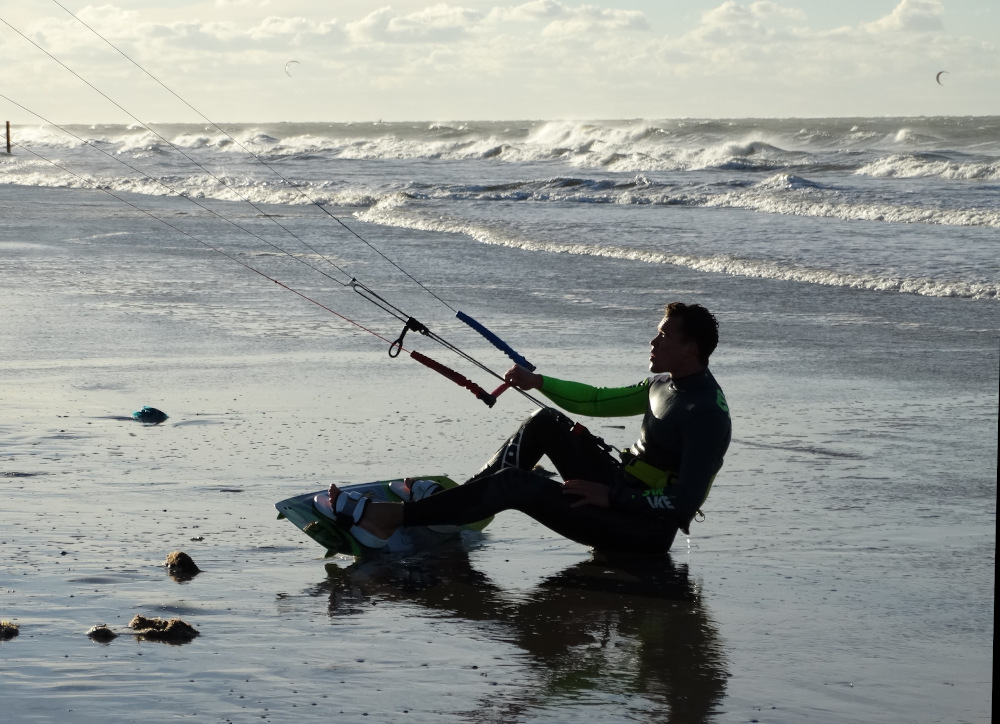Mhe winter wetsuit kite surfing is not an unnecessary luxury as soon as the temperature of the weather and water drops. Determining which winter wetsuit thickness you need is all about insulation. Insulation provides protection against the water temperature and temperature of the outside air. We are talking about winter here, but of course we also mean cold days in the spring and autumn.
Determine winter wetsuit thickness
In order to be able to advise you properly, we have used 2 datasets from the KNMI. This is the average outside air temperature per month and the average water temperature per month. We use this data to help you understand what thickness wetsuit you need for kite surfing.
Overview thickness wetsuit kite surfing
| Month | Outside temperature | Water temperature | Thickness wetsuit |
|---|---|---|---|
| January | 1,4 ° C | 5,5 ° C | 6/4 mm |
| February | 2,5 ° C | 4,5 ° C | 6/4 mm |
| March | 4,7 ° C | 5,7 ° C | 6/4 mm or 5/4 mm |
| April | 8,2 ° C | 7,3 ° C | 5/4 mm |
| Mei | 12,3 ° C | 11,7 ° C | 5/4 mm |
| June | 15,2 ° C | 14,8 ° C | 4/3 mm |
| July | 16,9 ° C | 17,5 ° C | 4/3 mm or 3/2 mm |
| August | 16,7 ° C | 20 ° C | 4/3 mm or 3/2 mm |
| September | 14,2 ° C | 19 ° C | 4/3 mm |
| October | 10 ° C | 17,2 ° C | 4/3 mm |
| November | 5,5 ° C | 13 ° C | 5/4 mm |
| December | 2,7 ° C | 8 ° C | 5/4 mm or 6/4 mm |
Not to forget the 'windchill factor'
In most cases, the water temperature and outside temperature are decisive factors for kite surfers when choosing a wetsuit. However, there is one important factor that should not be forgotten. This is the wind chill factor which indicates the so-called wind chill. This provides insight into how cold it is when you combine wind and temperature. The wind chill factor is especially important for kite surfers because you are mostly above the water and not in the water.
'The wind chill factor is especially important for kite surfers because you are mostly above the water and not in the water.'

Numbers indicate wetsuit thickness
The numbers indicate the thickness of the neoprene. This is in millimeters. For example, a 5/4 wetsuit has neoprene of 5 mm and 4 mm. The thick neoprene is actually always on the chest, back and waist. The thinner parts of the body are usually the legs and arms. This provides more flexibility for the body parts that move continuously and extra warmth on the chest and back.
"If you only buy one wetsuit, then a 5/3 mm is recommended."
Buying a wetsuit guide
As a guide you can use a 4/3 mm or 3/2 mm in the summer and at the beginning of autumn when the water temperature is still high after the summer. For winter and spring you need at least a 5/4 mm wetsuit for kite surfing. If you only purchase one wetsuit, a 5/4 mm is recommended. This thickness can actually be used all year round in the Netherlands, with the exception of the really cold winter days with a poor wind from the north.
Extra points of attention for the thickness of the kitesurf winter wetsuit
- If you are cold, a thick wetsuit will soon be great to wear.
- If you often go for long sessions and you stay at the beach for a long time, a thick wetsuit is also nice to wear.
- If you are a beginner and you are still in the water a lot, then a thicker wetsuit and therefore slightly more warm is more comfortable.
- If you go for a short and active session, then a slightly thinner wetsuit is often fine.
- A thinner wetsuit is more flexible than a thick wetsuit. A thick wetsuit is stiffer.
- A wetsuit must be tight. Then the insulation works best.

Neoprene shoes, gloves and a cap
As soon as it gets really cold you sure have neoprene surf shoes required. You can't live without it in the winter. You may also choose for neoprene gloves and an Postal Code.
In one of the following kitesurf blogs we answer the question 'What size wetsuit do I need?'



